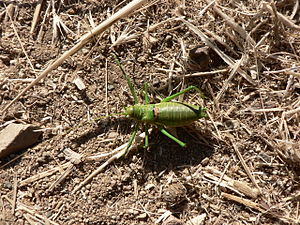Angular saddle bug
| Angular saddle bug | ||||||||||||
|---|---|---|---|---|---|---|---|---|---|---|---|---|

Angular saddle insect ( Uromenus rugosicollis ) |
||||||||||||
| Systematics | ||||||||||||
|
||||||||||||
| Scientific name | ||||||||||||
| Uromenus rugosicollis | ||||||||||||
| ( Serville , 1839) |
The angular saddle insect ( Uromenus rugosicollis ) is a long- feeler insect from the subfamily Bradyporinae within the family Tettigoniidae . Serville described it in 1838 under the name Ephippiger rugosicollis . Other synonyms are Ephippigera rugosicollis , Ephippigera vespertinus , Ephippiger durieui and Barbitistes autumnalis .
features
The species reaches a body length of 25 to 31 millimeters. The body shape corresponds to the typical habit of the saddle terror with very large, backward early pronotum , of the fuselage largely covered with a clear profile kink approximately in the middle. The surface of the pronotum is clearly wrinkled in the species (from which the species name is derived), the pronotum has very clear, bulging side keels. The deck wings ( Tegmina ) are greatly shortened in both sexes. In the male, the tenth tergite of the abdomen is fused with the supragenital plate and ends in a rounded lamella, the cerci are relatively long and serrated in the middle, while the end tooth is rounded. In the female, the ovipositor is curved upwards and slightly shorter than in the related species, it is almost half as long as the body. The subgenital plate has two long and pointed appendages that are broadly separated at the base. The animals are mostly almost monochrome green with a yellowish longitudinal band on the sides of the abdomen, but can also be completely yellowish. The wings are yellow-brown with small black spots on the outer edge.
Way of life and distribution
The angular saddle bug lives in heaths, bushland and also damp areas with a lot of vegetation near the water. It lives from sea level to about 1250 meters above sea level. The species is predominantly nocturnal with activity maximum at dusk. Adults occur from July to November.
Their distribution area extends over Spain and the Pyrenees to southern France . The distribution in France extends on the Atlantic coast to the mouth of the Loire , Gascony , the south of the Massif Central and Languedoc ; in France the species is not uncommon and not endangered, occasionally it even came to mass reproduction. In Spain she lives in the provinces of Gerona and Barcelona in the Pyrenees and near the Mediterranean coast.
swell
literature
- Heiko Bellmann : The Cosmos Locust Leader. Determine the species of Central Europe with certainty. Franckh-Kosmos Verlags GmbH & Co. KG, Stuttgart 2006, ISBN 3440104478
- Heiko Bellmann: Observe and determine locusts. Naturbuch, Augsburg, 2nd edition 1993. ISBN 3-89440-028-5
- Josep Maria Olmo-Vidal (2006): Atlas of the Orthoptera of Catalonia (Atlas of Biodiversity No. 1).
Individual evidence
- ↑ Karim Vahed (2006): Comparative evidence for a cost to males of manipulating females in bushcrickets. Behavioral Ecology Volume 18 Issue 3: 499-506.
- ↑ Bernard Defaut (1984): Sur la repartition d'Uromenus rugosicollis (Serville) (Ensifera, Ephippigerinae). L'Entomologiste 40 (3): 119-122.
- ↑ Eric Sardet & Bernard Defaut (2004): Les Orthopteres menaces en France. Matériaux Orthoptériques et Entomocénotiques, 9: 125-137.
- ↑ J. Feytaud (1930): Sur une invasion d'éphippigéres. Revue de Zoologie Agricole Vol. 29 No. 5: 69-79.
- ↑ SK transition Were & E. Morales Agacino (1979): The biogeography of iberian orthopteroids. Miscelánea Zoologica 2 (5): 9-75.